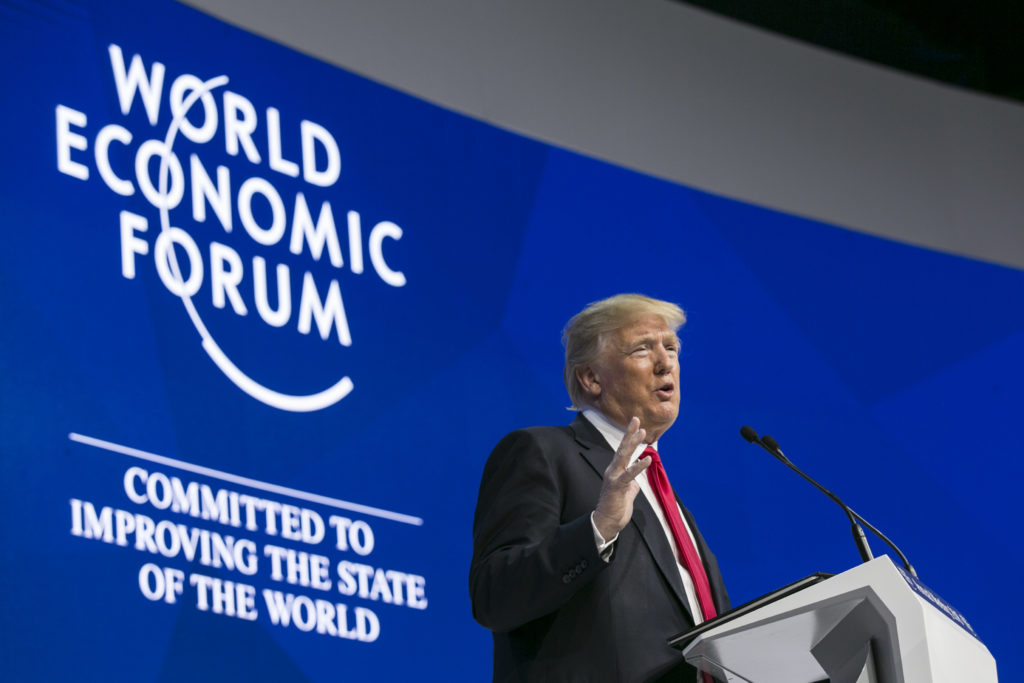A nation must think before it acts.

Donald J. Trump speaking at the 2018 World Economic Forum in Davos. (Source: World Economic Forum/Faruk Pinjo)
As corporate titans from the world gathered at Davos, it should have not been a surprise that U.S. President Donald Trump would choose the Swiss Alps as the venue to tone down his hostility towards multilateral trade deals. Having campaigned vigorously against the Trans-Pacific Partnership (TPP) agreement and multilateral pacts in general, Trump suggested at the World Economic Forum last week that he might reconsider being part of the TPP under the right conditions. For trade analysts, though, the immediate concerns are less about what changes may be made to accommodate the White House’s renewed interest in the world’s most ambitious trade agreement to date that is re-emerging without the United States. Rather, the focus is on how the TPP will continue moving forward without Washington to ensure that global growth remains steady. Most importantly, perhaps, is that there is now a concrete roadmap to see how firm U.S. allies can begin making a world without Washington a reality.
For the executives, political leaders, and big thinkers gathered at Davos, this year’s annual meeting was undoubtedly an opportunity to congratulate themselves on steering the global economy on a steady, upward trajectory. The U.S. stock market’s remarkable performance over the past year has been thrilling for investors, but bourses from Japan to Europe and China as well as Russia have all been faring well. In fact, economies across the board are growing at a steady clip, which is a marked turnaround from the financial crisis the world had confronted a decade ago.
The camaraderie among the international elite at Davos would seemingly ensure that greater cooperation and coordination to mitigate risks is on the upswing. Establishing rules that would not only allow further growth—but also allow hedging against shocks in one particular region—is a common objective for the investing class. For the Davos set, coordinating and cooperating more on the economic front would be de rigeur. Yet, one of the prevailing themes at the Swiss forum was about the gains made over the past decade being hurt or even wiped out as a result of a trade war based on economic nationalism. One of the most articulate voices expressing such concerns was Alibaba’s Jack Ma, who warned, “It’s so easy to launch a trade war, but it’s so difficult to stop the disaster of this war.”
In such a climate, President Trump’s seeming change of heart about multilateral trade deals and the TPP in particular was somewhat reassuring. Still, stating that “I would do TPP if we were able to make a substantially better deal,” without clarifying what exactly was lacking in the deal has left many scratching their heads about whether or not he actually would be open to getting back into the deal—assuming that the conditions were acceptable to the White House. Moreover, his comment that bilateral trade deals were preferable to multilateral agreements “because if you have a problem, you terminate” them hardly sounded like a comment that would push the United States back in. So given the vagueness of the administration, the U.S. president’s latest comments about TPP is unlikely to derail the agreement that is now gathering steam.
U.S. withdrawal from the trade agreement a year ago was seemingly the death knell for TPP. Yet, since then, the remaining 11 countries led by Japan have continued to press forward with taking the deal across the finish line. Expectations are high that the TPP11—which is in essence the same content as the original deal—could actually be signed as early as March. These expectations are a testament to the strength of the pact. Its ambitions to go far beyond a traditional trade deal and focus much more on reducing non-tariff barriers and to address issues that have hitherto been neglected by trade agreements, including intellectual property rights and dealing with state-owned enterprises, is certainly attractive to the 11 countries, namely Japan, Australia, New Zealand, Singapore, Brunei, Vietnam, Malaysia, Chile, Peru, Mexico, and Canada. For Mexico and Canada, which continue to renegotiate NAFTA with the United States, moving ahead with TPP11 will give both countries more leverage, not to mention political support, in dealing with a U.S. administration that remains fixated on reducing bilateral trade deficits above all else.
Equally important is the political momentum stemming from TPP11’s advancement. Much has been made about U.S. withdrawal from the TPP signaling Washington’s weakened commitment to remain an Asian power. Meanwhile, China’s growing ambitions to consolidate its position as Asia’s biggest economic, political, and military power, and the role the Belt and Road Initiative plays in making that a reality have come under close scrutiny. But the steady regeneration of the TPP even without the United States signals perhaps a much more steady, and perhaps more sustainable, approach to the shift in political realities to fill the vacuum the United States has left behind. The TPP11 has made clear that the world can indeed move on without Washington, but there are also alternatives to Chinese-led visions for growth.




